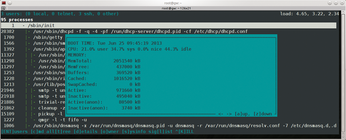The sys admin's daily grind: Whowatch et al.
On Patrol
For no particular reason, Charly occasionally patrols his server farm and hunts down attackers. He has put together a neat toolbox for this job.
Every server with an IP address on the Internet will receive uninvited visits at some point. The usual scans and scripted carpet bombing simply bounce off my machines thanks to clever firewalling, port knocking [1], and additional tools like Fail2ban [2]. To keep attackers from working around my defenses, I use two rootkit hunters: Rootkit Hunter [3] and Chkrootkit [4]. The latter, unfortunately, accuses my DHCP server of packet sniffing:
eth0: PACKET SNIFFER(/usr/sbin/dhcpd[28382])
This result is a known false positive, which I ignore. As an interim report, I can say that my varmint hunters have not seen any prey thus far.
Nevertheless, I occasionally go on patrol to see whether a server is behaving strangely. I like to use whowatch [5] for this purpose. This tool launches in the terminal with a process list; the second column shows me the owner. In the third column, Whowatch tells me whether the user is local or logged on via SSH, Telnet, or in some other way. For remote users, this information is followed by the IP address, and for local users, just :0.
Hotkey Control
I have two ways of navigating this information: I can use the arrow keys to select a line, press Enter, and see a tree view of the associated processes, as shown in Figure 1. Pressing O (owner) hides or displays the process owner; pressing D (details) creates a window with detailed information for the process.

My second option is to type T (tree view) to show all running processes. In this tree view, too, pressing D will display more information. Pressing L (list of signals) shows me the control signals that I can send to the process, such as HUP, INT, TERM, and in an emergency KILL. I can display the overall system status, particularly in terms of memory management, by pressing S (sysinfo), which tells Whowatch to display the total load on the screen, in a style very much reminiscent of top (Figure 2).

I have never found anything dangerous on my server patrols to date, but I do like that warm, safe, and cozy feeling.
Infos
- Fwknop: http://www.cipherdyne.org/fwknop/
- Fail2ban: http://www.fail2ban.org
- Rootkit Hunter: http://rkhunter.sourceforge.net
- Chkrootkit: http://www.chkrootkit.org (in Portuguese)
- Whowatch: http://whowatch.sourceforge.net
Buy this article as PDF
(incl. VAT)
Buy Linux Magazine
Subscribe to our Linux Newsletters
Find Linux and Open Source Jobs
Subscribe to our ADMIN Newsletters
Support Our Work
Linux Magazine content is made possible with support from readers like you. Please consider contributing when you’ve found an article to be beneficial.

News
-
Linux Servers Targeted by Akira Ransomware
A group of bad actors who have already extorted $42 million have their sights set on the Linux platform.
-
TUXEDO Computers Unveils Linux Laptop Featuring AMD Ryzen CPU
This latest release is the first laptop to include the new CPU from Ryzen and Linux preinstalled.
-
XZ Gets the All-Clear
The back door xz vulnerability has been officially reverted for Fedora 40 and versions 38 and 39 were never affected.
-
Canonical Collaborates with Qualcomm on New Venture
This new joint effort is geared toward bringing Ubuntu and Ubuntu Core to Qualcomm-powered devices.
-
Kodi 21.0 Open-Source Entertainment Hub Released
After a year of development, the award-winning Kodi cross-platform, media center software is now available with many new additions and improvements.
-
Linux Usage Increases in Two Key Areas
If market share is your thing, you'll be happy to know that Linux is on the rise in two areas that, if they keep climbing, could have serious meaning for Linux's future.
-
Vulnerability Discovered in xz Libraries
An urgent alert for Fedora 40 has been posted and users should pay attention.
-
Canonical Bumps LTS Support to 12 years
If you're worried that your Ubuntu LTS release won't be supported long enough to last, Canonical has a surprise for you in the form of 12 years of security coverage.
-
Fedora 40 Beta Released Soon
With the official release of Fedora 40 coming in April, it's almost time to download the beta and see what's new.
-
New Pentesting Distribution to Compete with Kali Linux
SnoopGod is now available for your testing needs

